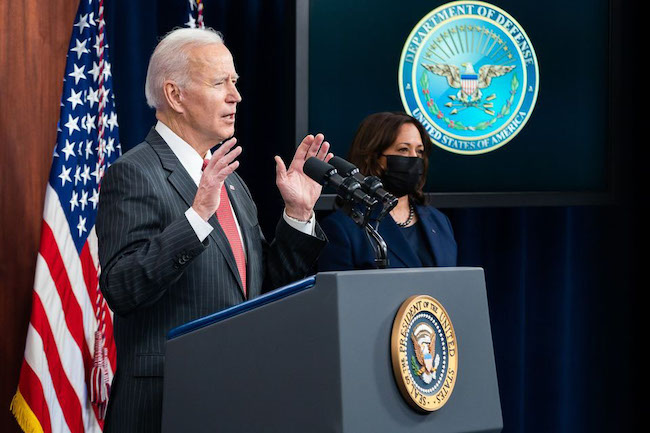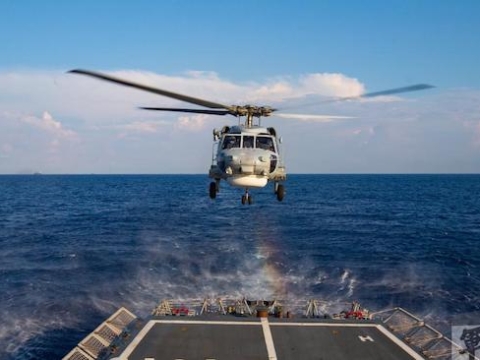
Will America Defend Taiwan? Here’s What History Says
June 30, 2021
An Elegant Solution for the Olympics
July 8, 2021By: Jae Chang |
The Biden Administration brings new opportunities to strengthen U.S. Indo-Pacific policy by better coordinating with our allies and partners against the People’s Republic of China’s (PRC, China) military, political, and economic coercion. The Chinese Communist Party (CCP) and its People’s Liberation Army (PLA) have jeopardized the economic prosperity and liberal democratic values that have benefited the Indo-Pacific since the mid-20th century. To address the threat posed by the CCP and PLA, U.S. policy should energize coordinated competition with like-minded partners in the Indo-Pacific region to bolster cooperation mechanisms and develop a priority list of near-term action items.
Sitting at the top of that priority list is the Republic of China (ROC, Taiwan). Taiwan is a beacon of democracy in a region with many authoritarian regimes. It boasts a formidable high-tech economy and is a world-leader in the critical field of semiconductor manufacturing. It is a responsible stakeholder in transnational issues such as health, renewable energy, and humanitarian assistance and disaster relief (HA/DR). In addition, Taiwan has a strategically important geographic position. U.S. support for Taiwan’s defense is not only critical for maintaining democratic values in the region, but also for curbing rampant CCP influence and PLA power projection throughout the Indo-Pacific.
No Indo-Pacific state will go unaffected by a major breach in cross-Strait stability. Taiwan should be thought of as a modern-day Indo-Pacific Fulda Gap. During the Cold War, the Fulda Gap in West Germany was perceived by NATO war planners as a weak point and the main route for a Soviet invasion. It became the focal point for defense innovation. American and allied weapons systems and strategies were developed with this potential battlefield in mind. Their success contributed to broader strategic stability. As with all analogies, framing Taiwan as an Indo-Pacific Fulda Gap is imperfect. However, it is useful to contextualize Taiwan as a specific geographic location wherein political and military interests collide. As with the Fulda Gap, Taiwan’s fate has ramifications not only for cross-Strait security or for U.S.-China relations, but also for the global security architecture.
The Weight of the U.S. Alliance NetworkÂ
Relentless and increasing CCP coercion is a clear and present danger to regional stability. However, while CCP and PLA capabilities are increasing, the U.S. alliance network undoubtedly wields the most influence today. This is clearly evidenced by economic indicators and global support for liberal democratic values.
The U.S. and its allies and partners need to take advantage of their global economic strength by integrating their economies to defend against China’s growing economic aggression. According to the World Bank, China holds 15% of the global gross domestic product. The U.S. and its allies have 36%.[1] The United States’ competitive advantage in technology and innovation is unquestioned, and the rise of the digital economy will only compound that strength as international partners need U.S. expertise and technology. In the region, U.S. allies and partners are connected by a robust supply chain of critical technologies, such as semiconductor production in Taiwan and the Republic of Korea (ROK, South Korea). The U.S. and its likeminded partners have the power to set trade rules and defend the flow of commerce interweaving the Indo-Pacific’s sea lines of communication (SLOCs).
The U.S. alliance network is resilient because it is supported by nations with shared values. Taiwan, Japan, Australia, India, and others desire to maintain the rule of law and freedom of navigation and trade, support human rights, and respect smaller nations through multilateral organizations and adherence to the norms they establish. The Chinese Communist Party appears to envision a regional governance system wherein its legitimacy to dictate the rules is based on its size and military power. However, the U.S. alliance network still outweighs the hard power of the PLA. That should not be forgotten, and neither should the fact that the alliance’s power is legitimized by our common fundamental principles, not “might makes right.â€
Addressing the First Priority
PRC use of force against Taiwan represents the most likely point of conflict between China and the U.S. alliance network. The U.S. and its allies need to address both Taiwan’s status in the international community, and the CCP’s aggression towards Taiwan and power projection throughout the region. The alliance network can develop coordinated security policy objectives that accurately target the problem. Three of the most significant issue areas are the PLA’s military threat, Taiwan’s ostracism from the international community, and Chinese economic coercion.
Over the last five years, The PLA has increased air operations in and around the Taiwan Strait. Systematic PLA intrusions into Taiwan’s Air Defense Identification Zone (ADIZ) strains the Taiwanese military and defense systems. In 2020, Taiwan’s Air Force sortied 4,132 fighters in response to PLA flight activity.[2] Taiwan faces serious hurdles in maintaining its aircraft availability rates due to lengthy waiting periods for parts acquired through U.S. foreign military sales (FMS). This is an obstacle that senior-level coordination could help to streamline. For Taiwan to continue to repel CCP coercive activities, it needs to coordinate with the U.S. and its partners in the region to strengthen its capacity to deter the PLA.
The CCP’s campaign to restrict Taiwan’s international presence is curbing an immense potential benefit to the global community. For example, Taiwan’s exclusion from the World Health Organization (WHO) during COVID-19 has caused countless lives to be lost. How many people could have been spared if Beijing had not prevented Taiwan’s successes in managing COVID-19 to be communicated effectively to the international community as a WHO member? The pandemic is definitive proof that Beijing’s obsession with limiting Taiwan’s international space has negative global repercussions.
Economic coercion involves not only Taiwan, but other Indo-Pacific countries as well. The Party’s campaign of economic coercion and espionage against Taiwan and the U.S. alliance network jeopardizes our shared supply chain of critical technology. Taiwan’s democracy and independence are threatened when the CCP uses targeted economic sanctions to punish Taiwan for not kowtowing to the Party’s political agenda. China succeeds by threatening countries individually. However, coordinating and encouraging economic trade that rewards democratic values, fair and free trade practices, and mutual respect for rule of law, can limit the effects of China’s unilateral bullying.
Recommendations
The new U.S. administration presents a time of opportunity. Washington’s perception of the Chinese Communist Party’s strategic objectives has become more accurate. The Party poses a clear and present danger to the shared values of the United States and its Indo-Pacific allies and partners. Yet, the alliance network still outweighs the PLA. It is a resilient alliance, based not on threat but on principles. The United States should energize its partners and support coordinated competition in the region. Taiwan, as the Indo-Pacific Fulda Gap, should be the first target of coordination. To begin, the United States should lead by example, and pursue the following recommendations:
- Enhance Taiwan’s International Space. The U.S. should support Taiwan’s participation in international organizations.
- Bolster Legitimacy of the American Institute in Taiwan (AIT): The Director of the American Institute in Taiwan should be a Senate-confirmed position to provide further legitimacy of the de facto embassy and allow the Director to have the same bona fides and equal standing as an ambassador. A President’s nomination and Senate approval demonstrate that both branches of government support the policy changes, which would require China to treat AIT’s director with the same respect as an ambassador.
- Amend the TAIPEI Act: The U.S. could amend the TAIPEI Act to include that the U.S. will oppose any moves by Beijing to exclude Taiwan from international organizations, such as the WHO.
- Encourage Taiwan’s Regional Economic Integration. The U.S. should encourage increased economic coordination among its allies and partners to strengthen Taiwan against CCP economic coercion.
- Support Taiwan’s participation in the Comprehensive and Progressive Agreement for Trans-Pacific Partnership (CPTPP): A tangible step forward here could be support for Japan’s leadership to include Taiwan in the Comprehensive and Progressive Agreement for Trans-Pacific Partnership (CPTPP). Japan is already a member of the CPTPP, a strong supporter of the U.S., and has a high-end economy reliant on semiconductors, which Taiwan can supply. Japan’s dominance of the supply chain throughout Southeast Asia could provide leverage with other members of the CPTPP for Taiwan’s inclusion.
ENDNOTES
[1] “China launches gray-zone warfare to subdue Taiwan,†Reuters, December 10, 2020, at https://www.reuters.com/investigates/special-report/hongkong-taiwan-military/.
[2] “GDP (current US$) World Bank National Accounts Data, and OECD National Accounts Data Files,†The World Bank, accessed May 4, 2021, at https://data.worldbank.org/indicator/NY.GDP.MKTP.CD?most_recent_value_desc=true.




